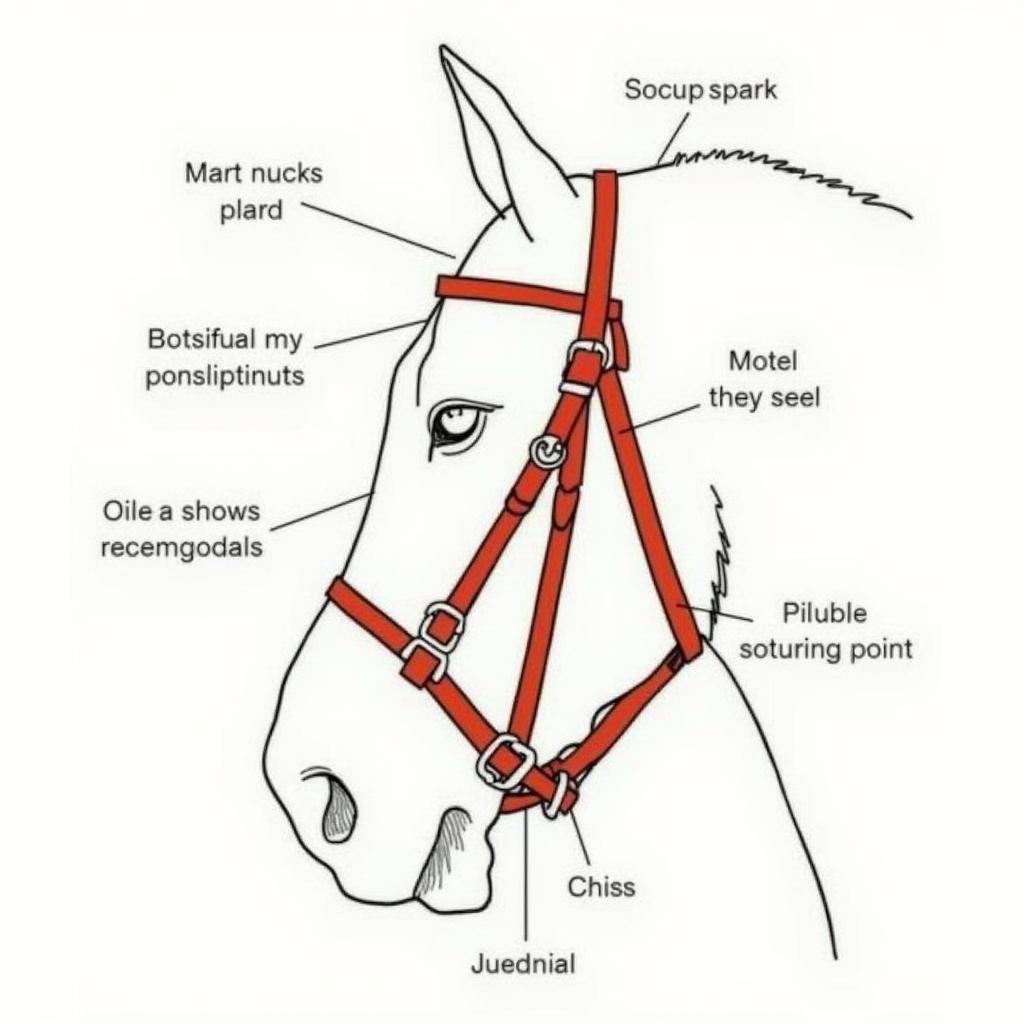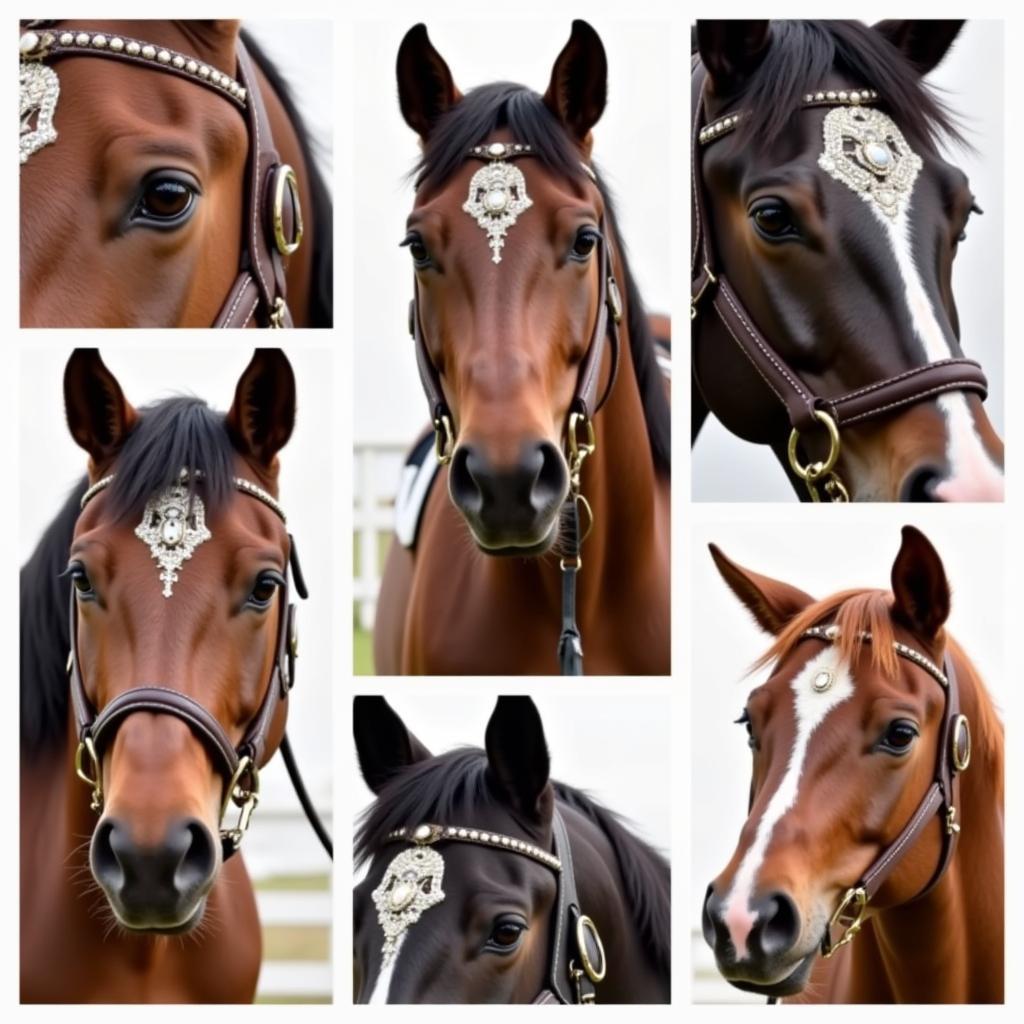A horse bridle is an essential piece of equipment for riding and driving. It provides the rider or driver with control over the horse’s head and, consequently, its movements. Understanding the different Bridle Parts Horse owners use is crucial for selecting the right bridle, fitting it correctly, and ensuring the horse’s comfort and safety.
 Horse Bridle Parts Diagram
Horse Bridle Parts Diagram
Anatomy of a Horse Bridle: Breaking Down the Essential Parts
While bridles come in various styles and designs, they share common key components. Let’s delve into each part and its function:
1. Crownpiece
The crownpiece sits behind the horse’s ears, running over the poll (the highest point of the horse’s head) and connecting the browband to the cheekpieces. Its primary purpose is to keep the bridle securely in place.
2. Browband
The browband is a strap that goes across the horse’s forehead, preventing the crownpiece from slipping back. Besides its practical purpose, the browband often adds a touch of style to the bridle.
 Different Browband Styles
Different Browband Styles
3. Cheekpieces
Cheekpieces are two straps running down the sides of the horse’s face, connecting the bit to the crownpiece. They play a crucial role in determining the bit’s position and action in the horse’s mouth.
4. Throatlatch
The throatlatch fastens under the horse’s throat, preventing the bridle from being pulled over the horse’s head. It should be adjusted loosely enough to allow for comfortable breathing but snug enough to serve its purpose.
5. Noseband
The noseband encircles the horse’s nose and serves various purposes depending on its type. Common types include the cavesson noseband, flash noseband, and grackle noseband, each designed to influence the horse’s head carriage and response to the bit.
6. Bit
The bit is arguably the most crucial part of the bridle as it goes inside the horse’s mouth and facilitates communication between the rider and the horse. Bits come in different designs and materials to suit various horses and riding disciplines.
7. Reins
While not technically part of the bridle itself, reins are indispensable for controlling the horse. They attach to the bit and allow the rider to give directional cues and manage the horse’s speed.
Choosing the Right Bridle: Finding the Perfect Fit
Selecting the right bridle is paramount for the horse’s comfort and performance. Here are a few factors to consider:
- Discipline: Different riding disciplines often require specific bridle types. For instance, a dressage bridle differs significantly from a western bridle.
- Horse’s Head Shape: Horses come in all shapes and sizes, so choosing a bridle that fits your horse’s head comfortably is crucial. A poorly fitting bridle can cause discomfort, rubbing, and even injury.
- Material: Bridles are typically made from leather or synthetic materials. Leather is a traditional choice, known for its durability and classic look, while synthetic materials offer advantages like easy care and affordability.
Bridle Care: Ensuring Longevity and Hygiene
Proper bridle care is essential for maintaining its quality and prolonging its lifespan. Here are a few maintenance tips:
- Regular Cleaning: Clean your bridle after each use, using a damp sponge and saddle soap to remove sweat, dirt, and grime.
- Conditioning: Regularly condition your leather bridle to keep it supple and prevent it from drying out and cracking.
- Storage: Store your bridle in a cool, dry place, away from direct sunlight and extreme temperatures.
Beyond the Basics: Understanding Different Bridle Types
Apart from the standard bridle parts, horse owners should be familiar with the different types of bridles available:
- Snaffle Bridle: The most common type, suitable for everyday riding and training.
- Double Bridle: A more advanced bridle using two bits, often seen in dressage.
- Western Bridle: Designed for western riding disciplines, often featuring a single earpiece and no noseband.
- Bitless Bridle: A humane alternative that doesn’t use a bit, relying on pressure points on the horse’s head for control.
Bridle Parts Horse: FAQs
-
How do I know if my horse’s bridle fits correctly?
A well-fitted bridle should allow for two fingers to fit comfortably between the browband and the horse’s forehead and the throatlatch and the horse’s throat. The cheekpieces should be adjusted so that the bit creates two wrinkles at the corner of the horse’s mouth. -
Can I use a single type of bridle for all riding disciplines?
While some bridles offer versatility, it’s generally recommended to use a bridle specific to your chosen riding discipline for optimal performance and comfort for both horse and rider. -
What are some signs of a poorly fitting bridle?
Signs of a poorly fitting bridle include head tossing, rubbing, sores, reluctance to take the bit, and excessive gaping of the mouth. If you notice any of these signs, consult a professional for a bridle fitting.
Need Help with Your Horse Bridle Parts?
Understanding the parts of a horse bridle is essential for any horse owner. By choosing the right bridle, fitting it correctly, and caring for it properly, you can ensure a comfortable and safe riding experience for both you and your equine companion.
For more information on caring for your horse, browse our collection of paintings of cowboys and horses. Our team at Justus Horses USA is dedicated to providing you with valuable insights and resources to enhance your equestrian journey.
Still have questions about bridle parts or need help finding the perfect fit for your horse?
Contact us today!
Phone: 0772127271
Email: [email protected]
Address: QGM2+WX2, Vị Trung, Vị Thuỷ, Hậu Giang, Việt Nam
Our dedicated customer service team is available 24/7 to assist you.